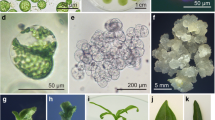Abstract
Nuclei isolated from metalaxyl-resistant (Mr) protoplasts of Phytophthora parasitica were transferred into chloroneb-resistant (Cnr) protoplasts of the same species, with an average successful rate of 1×10–4, using a selective medium containing both metalaxyl and chloroneb. No colonies appeared when self-fusion products of donor nuclei or recipient protoplasts were exposed to the selective medium. Similar results were obtained when the reciprocal nuclear transformation was performed. All the zoospore cultures produced by nuclear transformants contained both Mr and Cnr genes, demonstrating the occurrence of karyogamy since most zoospores are uninucleate. An average of 38% of zoospores produced by nuclear transformants were about twice the size of normal zoospores. Each large zoospore contained a single nucleus, also about twice the size of that in normal zoospores, indicating the occurrence of tetraploidy in these zoospores. The other 42% of zoospores were of normal size but contained both Mr and Cnr genes, suggesting the occurrence of mitotic crossing-over following the production of tetraploidy and the subsequent occurrence of diploidization during zoosporogenesis. For the first time, this study demonstrated the completion of events leading to a parasexual cycle following nuclear transfer.
Similar content being viewed by others
Author information
Authors and Affiliations
Additional information
Received: 2 April / 3 June 1998
Rights and permissions
About this article
Cite this article
Gu, YH., Ko, WH. Occurrence of a parasexual cycle following the transfer of isolated nuclei into protoplasts of Phytophthora parasitica. Curr Genet 34, 120–123 (1998). https://doi.org/10.1007/s002940050375
Issue Date:
DOI: https://doi.org/10.1007/s002940050375




